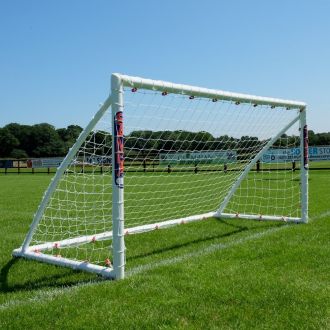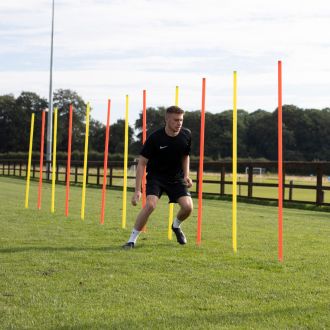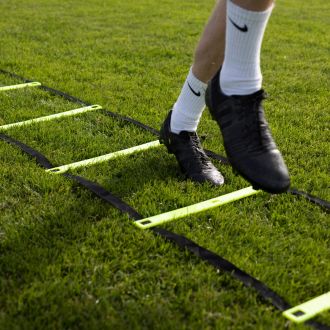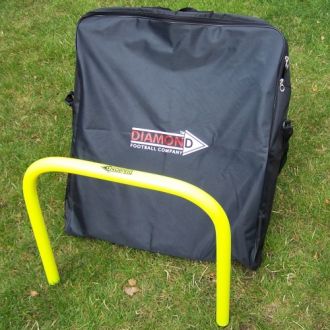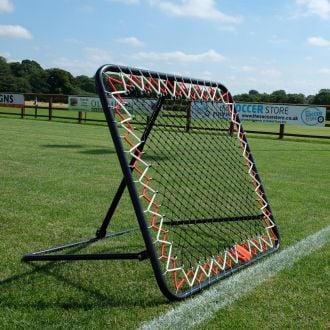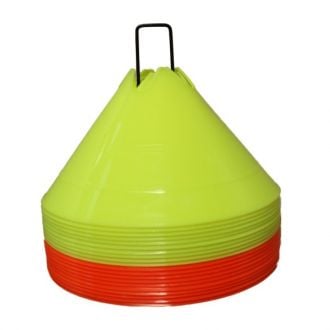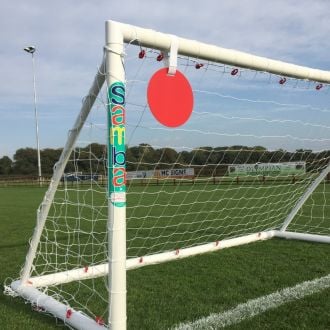5 Ways to Improve Your Core Football Skills
Football is a technical game that requires many different skills and traits. If you’re keen to develop your core football skills, however, there’s nothing that matches continuous practice. By spending hours on the training pitch, you can gradually improve the five key skills that can make you a better player.
But to truly maximise your potential, you’ll need more than a pair of boots and a ball. To replicate real match conditions and scenarios, you’ll need a few tools. Use them correctly, and you should be able to improve with regular practice and the right attitude.
1. Dribbling with cones or slalom poles
Dribbling involves moving with the ball — while maintaining control of its pace and direction. The closer you keep the ball to your feet, the less chance there is of an opposition player taking it from you. Dribbling is actually a combination of different skills, including:
- Balance
- Quick changes of direction
- Feints
- Creativity
- Reacting under pressure
- Touch and control
- Awareness of the people around you
If you can master all of these traits, you’ll be able to keep the ball closer to your feet for longer — even when you’re under pressure from the opposition.
A great way to hone your dribbling skills is by setting up courses using cones and slalom poles. Start with them placed relatively far apart, and as your skills and confidence grows, move them closer together. You can buy slalom poles and cones in sets or individually. The Diamond Mini Slalom Pole Set of 12, for example, includes two colours, a carry bag and the steel spikes needed to drive the poles into the ground.
2. Keepy-ups (touch and control) with a football rebounder
Touch and control relate to how well a player looks after the ball during possession. Can you control a long ball with a single touch, and leave it in a position that makes your next move easy? Can you set up a shot with a single touch? Can control the ball as you make runs, twists and turns?
Some players are born with a talent for touch and control. However, in order to fine-tune and maximise these essential skills, constant practice and repetition are essential. And a great way to do this is with regular keepy-up sessions.
Of course, you can simply use a ball for practice, but it won’t push you in terms of different angles, ball speeds and unpredictable outcomes (all of which occur during a real match). But using a rebounder can help to mix things up a little on the training pitch.
Consisting of a metal or plastic frame and an elasticated net, a rebounder makes keepy-ups and other control work far more challenging. You can buy rebounders either as standalone frames or large goals with their own free-standing support poles.
3. Shooting with a Samba goal and target sheet
Shooting practice always needs a target — whether you’re training for 11-a-side football or shorter forms of the game. To give you flexibility in both the location and types of training you do, consider using portable Samba goals.
Lightweight, durable and easy to construct, Samba goals are made with a virtually indestructible uPVC that is also resistant to sunlight. Complete with nets, clips and frame anchors, a Samba goal can be used almost anywhere — outside and indoors.
With the addition of a target sheet, you can turn any Samba goal into a tool for fine-tuning shooting skills. A target sheet attaches to the frame of a Samba goal, and gives the shooter up to eight target holes to aim for.
4. Passing accuracy with a passing arc
Passing is arguably the single most important skill required to play football at any level. It requires constant practice and development, which means you can’t afford to wait for training games and sessions.
By purchasing some passing arcs, you can turn your own garden into a training pitch. These metal frames are driven into the ground using steel spikes, and provide a challenging target for ground passes. Combine a few training arcs to create a training zone for both passing and control. Your personal game development doesn’t need to wait until other players are available when you have a set of passing arcs at your disposal.
5. Speed and agility with hurdles and ladders
Speed and agility are traits you develop over time — with regular training and playing. But recreating the types of match scenarios that develop speed and agility isn’t always easy. Core and lower-body strength are crucial, so the work needs to be challenging. Making fast and sharp turns while maintaining balance requires lots of practice, which is why hurdles and ladders are always an essential part of any coach’s inventory.
Speed hurdles are made with non-corrosive materials, so they’re suitable for use in all weather conditions. Lightweight and compact, they simply sit on the ground. Players jump over them at speed in various configurations. And because of their unique design, they return to their original position when they’re kicked and knocked over.
Speed ladders actually lie on the ground, and give players the opportunity to combine precise foot placement with speed and power. They’re available in straight or cross configurations, and can be folded away and stored in a dedicated carry bag in a matter of seconds.
Just a little help here and there from the right football equipment can develop your game quickly — and in a way that makes training fun.


